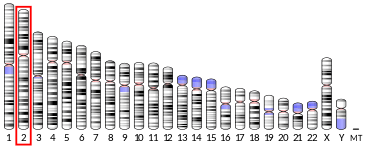ACVR1C
The activin A receptor also known as ACVR1C or ALK-7 is a protein that in humans is encoded by the ACVR1C gene.[5] ACVR1C is a type I receptor for the TGFB family of signaling molecules.[5]
ACVR1C transduces signals of Nodal. Nodal binds to ACVR2B and then forms a complex with ACVR1C. These go on to recruit the R-SMADs SMAD2 or SMAD3.[6]
Upon ligand binding, type I receptors phosphorylate cytoplasmic SMAD family transcription factors, which then translocate to the nucleus and interact directly with DNA or in complex with other transcription factors.[5]
References
- GRCh38: Ensembl release 89: ENSG00000123612 - Ensembl, May 2017
- GRCm38: Ensembl release 89: ENSMUSG00000026834 - Ensembl, May 2017
- "Human PubMed Reference:". National Center for Biotechnology Information, U.S. National Library of Medicine.
- "Mouse PubMed Reference:". National Center for Biotechnology Information, U.S. National Library of Medicine.
- Bondestam J, Huotari MA, Morén A, Ustinov J, Kaivo-Oja N, Kallio J, Horelli-Kuitunen N, Aaltonen J, Fujii M, Moustakas A, Ten Dijke P, Otonkoski T, Ritvos O (2001). "cDNA cloning, expression studies and chromosome mapping of human type I serine/threonine kinase receptor ALK7 (ACVR1C)". Cytogenet. Cell Genet. 95 (3–4): 157–62. doi:10.1159/000059339. PMID 12063393.
- Inman GJ, Nicolás FJ, Callahan JF, Harling JD, Gaster LM, Reith AD, Laping NJ, Hill CS (July 2002). "SB-431542 is a potent and specific inhibitor of transforming growth factor-beta superfamily type I activin receptor-like kinase (ALK) receptors ALK4, ALK5, and ALK7". Mol. Pharmacol. 62 (1): 65–74. doi:10.1124/mol.62.1.65. PMID 12065756.
External links
- Human ACVR1C genome location and ACVR1C gene details page in the UCSC Genome Browser.
Further reading
- Carlsson LM, Jacobson P, Walley A, et al. (2009). "ALK7 expression is specific for adipose tissue, reduced in obesity and correlates to factors implicated in metabolic disease". Biochem. Biophys. Res. Commun. 382 (2): 309–14. doi:10.1016/j.bbrc.2009.03.014. PMC 2681012. PMID 19275893.
- Reissmann E, Jörnvall H, Blokzijl A, et al. (2001). "The orphan receptor ALK7 and the Activin receptor ALK4 mediate signaling by Nodal proteins during vertebrate development". Genes Dev. 15 (15): 2010–22. doi:10.1101/gad.201801. PMC 312747. PMID 11485994.
- Andersson O, Korach-Andre M, Reissmann E, et al. (2008). "Growth/differentiation factor 3 signals through ALK7 and regulates accumulation of adipose tissue and diet-induced obesity". Proc. Natl. Acad. Sci. U.S.A. 105 (20): 7252–6. Bibcode:2008PNAS..105.7252A. doi:10.1073/pnas.0800272105. PMC 2438236. PMID 18480259.
- Watanabe R, Shen ZP, Tsuda K, Yamada Y (2008). "Insulin gene is a target in activin receptor-like kinase 7 signaling pathway in pancreatic beta-cells". Biochem. Biophys. Res. Commun. 377 (3): 867–72. doi:10.1016/j.bbrc.2008.10.074. PMID 18951876.
- Roberts HJ, Hu S, Qiu Q, et al. (2003). "Identification of novel isoforms of activin receptor-like kinase 7 (ALK7) generated by alternative splicing and expression of ALK7 and its ligand, Nodal, in human placenta". Biol. Reprod. 68 (5): 1719–26. doi:10.1095/biolreprod.102.013045. PMID 12606401.
- Hillier LW, Graves TA, Fulton RS, et al. (2005). "Generation and annotation of the DNA sequences of human chromosomes 2 and 4". Nature. 434 (7034): 724–31. Bibcode:2005Natur.434..724H. doi:10.1038/nature03466. PMID 15815621.
- Gerhard DS, Wagner L, Feingold EA, et al. (2004). "The status, quality, and expansion of the NIH full-length cDNA project: the Mammalian Gene Collection (MGC)". Genome Res. 14 (10B): 2121–7. doi:10.1101/gr.2596504. PMC 528928. PMID 15489334.
- Xu G, Zhong Y, Munir S, et al. (2004). "Nodal induces apoptosis and inhibits proliferation in human epithelial ovarian cancer cells via activin receptor-like kinase 7". J. Clin. Endocrinol. Metab. 89 (11): 5523–34. doi:10.1210/jc.2004-0893. PMID 15531507.
- Xu G, Bernaudo S, Fu G, et al. (2008). "Cyclin G2 is degraded through the ubiquitin-proteasome pathway and mediates the antiproliferative effect of activin receptor-like kinase 7". Mol. Biol. Cell. 19 (11): 4968–79. doi:10.1091/mbc.E08-03-0259. PMC 2575152. PMID 18784254.
- Strausberg RL, Feingold EA, Grouse LH, et al. (2002). "Generation and initial analysis of more than 15,000 full-length human and mouse cDNA sequences". Proc. Natl. Acad. Sci. U.S.A. 99 (26): 16899–903. Bibcode:2002PNAS...9916899M. doi:10.1073/pnas.242603899. PMC 139241. PMID 12477932.
- Kim BC, van Gelder H, Kim TA, et al. (2004). "Activin receptor-like kinase-7 induces apoptosis through activation of MAPKs in a Smad3-dependent mechanism in hepatoma cells" (PDF). J. Biol. Chem. 279 (27): 28458–65. doi:10.1074/jbc.M313277200. PMID 15107418.
- Munir S, Xu G, Wu Y, et al. (2004). "Nodal and ALK7 inhibit proliferation and induce apoptosis in human trophoblast cells". J. Biol. Chem. 279 (30): 31277–86. doi:10.1074/jbc.M400641200. PMID 15150278.
- Xu G, Zhou H, Wang Q, et al. (2006). "Activin receptor-like kinase 7 induces apoptosis through up-regulation of Bax and down-regulation of Xiap in normal and malignant ovarian epithelial cell lines". Mol. Cancer Res. 4 (4): 235–46. doi:10.1158/1541-7786.MCR-05-0174. PMID 16603637.
- Tsuchida K, Nakatani M, Yamakawa N, et al. (2004). "Activin isoforms signal through type I receptor serine/threonine kinase ALK7". Mol. Cell. Endocrinol. 220 (1–2): 59–65. doi:10.1016/j.mce.2004.03.009. PMID 15196700.
This article is issued from Wikipedia. The text is licensed under Creative Commons - Attribution - Sharealike. Additional terms may apply for the media files.



